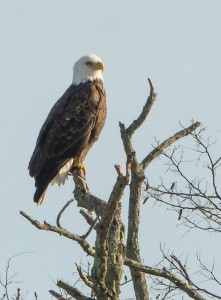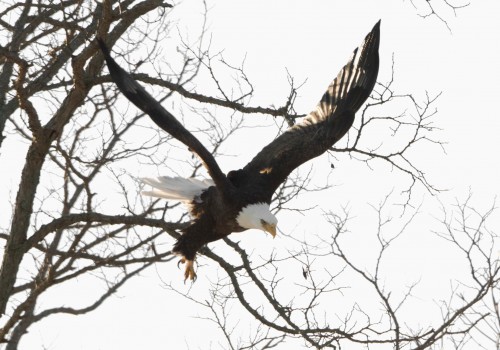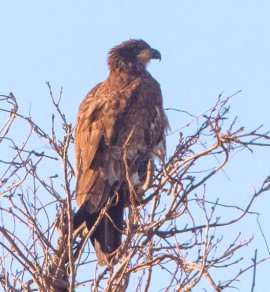Just 10 years ago, spotting a bald eagle on Long Island was almost unheard of.
But thanks to decades of environmental conversation efforts, our nation’s mascot has become an increasingly frequent sight on the North Fork.
“I’ve had about 50 sightings in the past year,” said Sean Keenan, a local wildlife activist and educator who lives in Rocky Point.
Keenan says he comes to Riverhead with his girlfriend every weekend to try to spot a bald eagle. “Our favorite thing to do this winter was to sit on the boardwalk and look for them,” he said. He has taken pictures of several from the riverfront parking lot downtown.
“The first time I saw one, I really couldn’t believe it,” Kennan said. “It was so exciting. It makes you feel like all the hard work at conserving open space is starting to finally pay off.”
Bald eagles once prospered in New York, with more than 70 nesting pairs living in the state year-round and several hundred more spending the winter here. But the widespread use of pesticides in the mid-20th century, particularly the insecticide DDT, diminished New York’s population of bald eagles to near extinction.
“DDT interfered with the birds’ ability to reproduce,” said Michael Scheibel, manager of Mashomack Preserve on Shelter Island and a former DEC senior wildlife biologist. “It nearly wiped them out.”
By the 1960s, only 500 bald eagles were left in the entire nation. DDT released into bald eagle habitats was thinning the birds’ egg shells, poisoning and killing off their young. With the fate of the country’s national animal uncertain, Congress decided to ban the agricultural use of DDT in 1972, which was followed by the federal Endangered Species Act of 1973.
But New York’s bald eagle population had already dwindled to just one nesting pair. So three years later, the New York State DEC launched its Bald Eagle Restoration Project, during which almost 200 nesting bald eagles from Alaska and other states were transported to New York and then hand reared them until they had adjusted to their new home.
The project was a success. Ten breeding pairs – which are pairs of male and female bald eagles that are actively breeding – were established in New York by the end of the program in 1989. More than 170 pairs are nesting in New York today.
Those eagles, however, settled mostly upstate. It was not until about 10 years ago that bald eagles were spotted on Long Island again.
“They’re becoming more and more common here all the time,” said Scheibel.
But are they nesting here? That’s the real question, according to DEC wildlife biologist Chip Hamilton, who specializes in New York’s bald eagle population. Although there have been some juvenile bald eagles spotted on Long Island – including over the Peconic River in downtown Riverhead – Hamilton pointed out that that doesn’t mean they were born here.
“These eagles have a very large range,” Hamilton said. “What we’re seeing is probably a range expansion from the Hudson River Valley area.”
The DEC has never confirmed a nesting fledgling success for any bald eagles on Long Island. There is a pair that is nesting at the William Floyd Estate, Hamilton said, as well as a pair on Shelter Island, but it would be “significant” if either of these pairs began incubating.
But the appearance of bald eagles in Riverhead and around the North Fork has certainly gotten local birders attention. “It’s been attracting people from all around Long Island,” said Keenan. “There were probably 12 or 15 birders yesterday all down [at the riverfront] with their binoculars and their cameras.”
The eagles are certainly a breathtaking sight. Standing at about 30 inches tall, bald eagles are among the largest birds of prey with a wingspan between 72 to 84 inches. They are also heavy, weighing between eight and 14 pounds. Their characteristic white-feathered heads – bald eagles are not actually bald – and brown body make them easy to identify, but fledgling bald eagles do not gain their white heads and tails until about five years of age.
Bald eagles mate for life, and they usually nest within 250 miles of the location where they were fledged. A pair that selects a nesting territory will stay there for the rest of their lives.
“They’re so majestic,” said Keenan. “Just to watch them fly around… They’re such beautiful birds.”
The survival of local journalism depends on your support.
We are a small family-owned operation. You rely on us to stay informed, and we depend on you to make our work possible. Just a few dollars can help us continue to bring this important service to our community.
Support RiverheadLOCAL today.































